Where Is The Cook Strait?

A strait is a narrow waterway that is naturally formed and connects two larger bodies of water. Located in New Zealand, the Cook Strait acts as a divide between New Zealand’s North and South Islands, and connects the South Pacific Ocean and the Tasman Sea. Situated next to New Zealand's capital, Wellington, the straight is widely regarded as extremely unsafe and unpredictable. The strait, which has a width of 14 miles at its narrowest point, was named after British explorer James Cook, who became the first European commander navigate it in 1770.
Water and Tides
The waters of Cook Strait have strong tidal flows. Additionally, the flow is unusual due to the difference in tidal elevation on either side. Essentially, waters on either side are out of phase, with one flow higher than the other. Submarine ridges off the coast also further impact the ocean flow. Despite these differences, the center experiences a negligible change in tidal height since water from both sides cancels each other out. Normally, one side experiences a tidal surge for a period of about six hours before the other side experiences a tidal surge. In poor weather, this period can last as long as eight or ten hours. Experts estimated that the tidal flow in Cook Strait could be harnessed to produce hydroelectric power through the addition of underwater tidal stream turbines. In fact, a company, Neptune Power, claimed there was potential to produce up to 12 GW of electricity, which actually exceeds the energy needs of New Zealand. However, harnessing power from the tidal flows proved more challenging in practice, and the turbine was never built.
Transportation
Regular ferry service operates in Cook Strait, running from Picton, Marlborough Sounds, and Wellington. The full ferry trip covers a distance of approximately 43 miles over about three hours. Due to the dangerous nature of the waters, ferry service is sometimes disrupted. In 1968, the TEV Wahine ferry capsized while carrying 610 passengers and 123 crew, resulting in 53 deaths.
Marine Life
Cook Strait is known for its diverse marine life, especially cetacean species such as dolphins and whales. Dolphin species in Cook Strait include the bottlenose dolphin, Hector’s dolphin, dusky dolphin, and common dolphin. Whale species include the killer whale, long-finned pilot whale, and humpback whale. Other whale species occasionally swim through the strait, such as the southern right whale, sperm whale, blue whale, and sei whale. In addition to dolphins and whales, other marine animals that inhabit Cook Strait include the broadbill swordfish, mako shark, albacore tuna, and marlin.
Swimming the Strait
Despite its long length, numerous people have swum Cook Strait. According to oral tradition, Hine Poupou was the first female to swim Cook Strait, although the exact year is unknown. In recent history, Barrie Devenport and Lynne Cox were the first male and female to swim the strait in 1962 and 1975, respectively.











